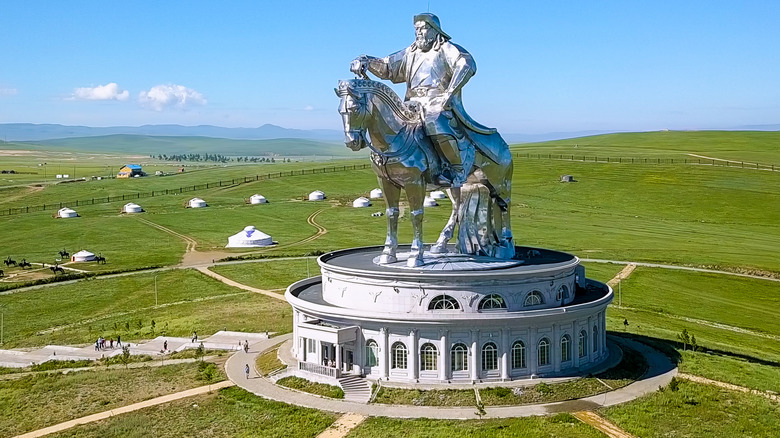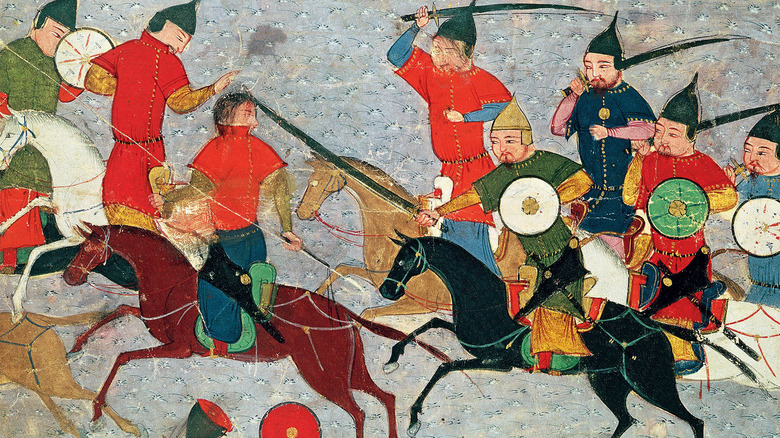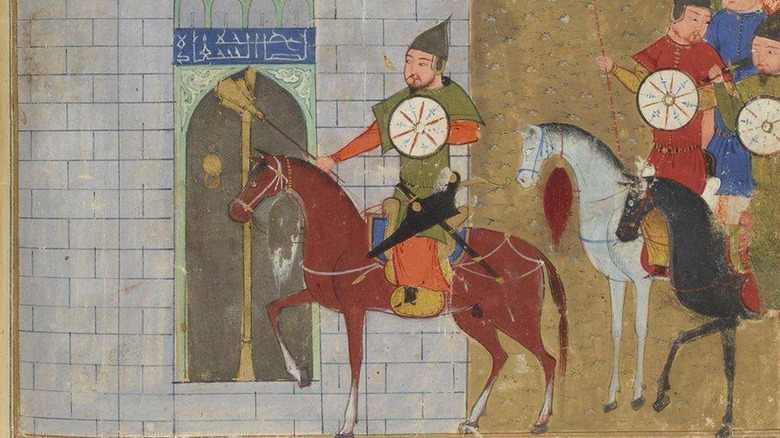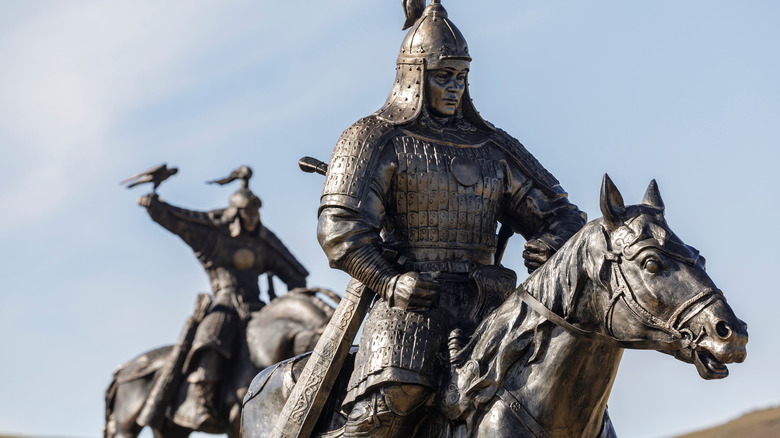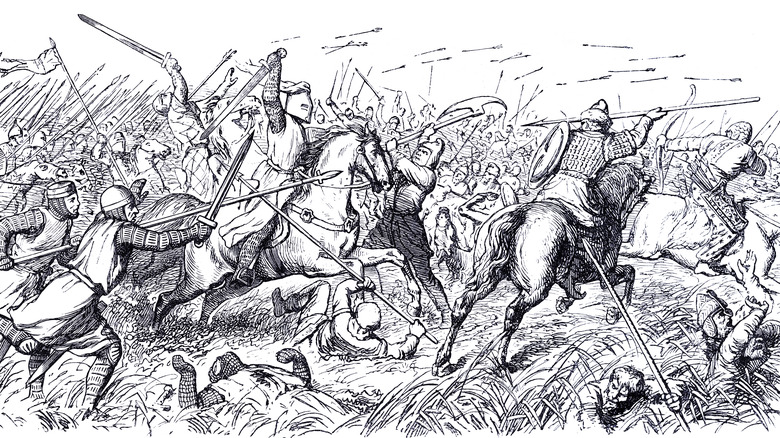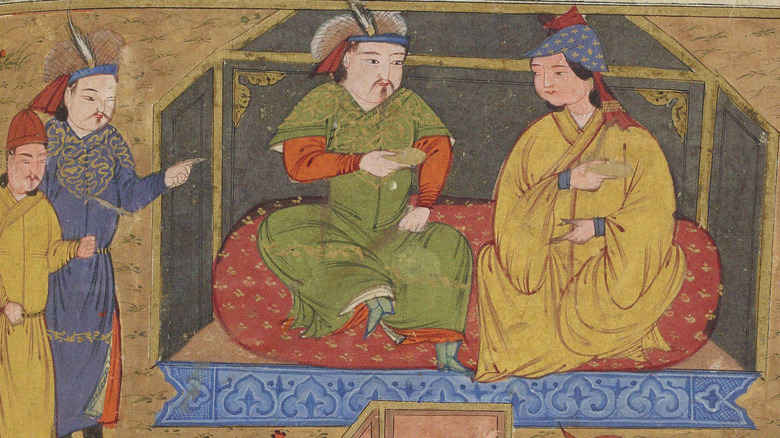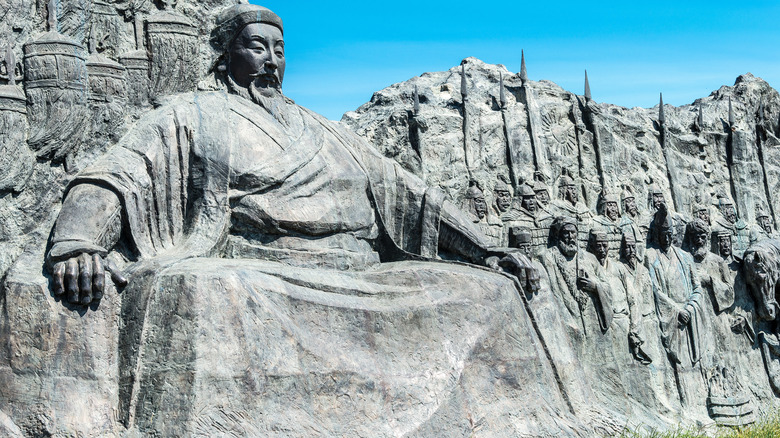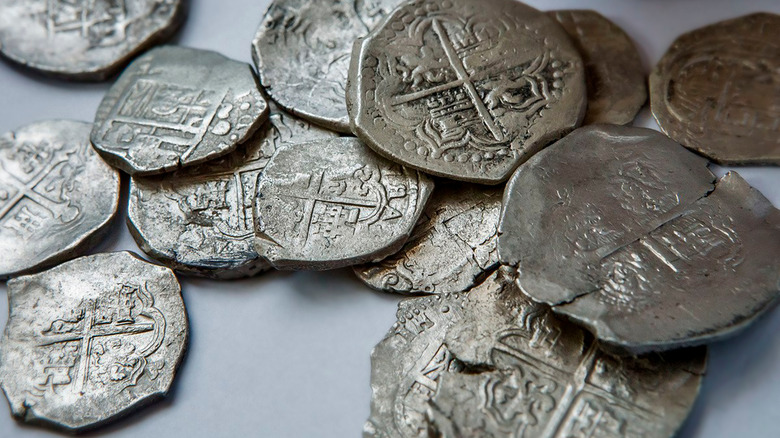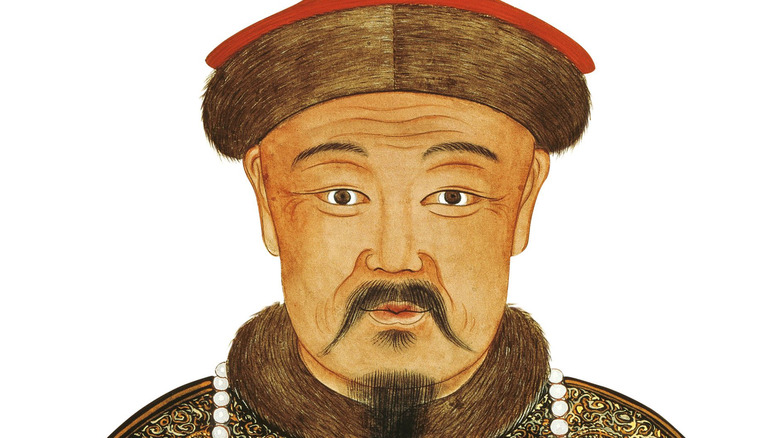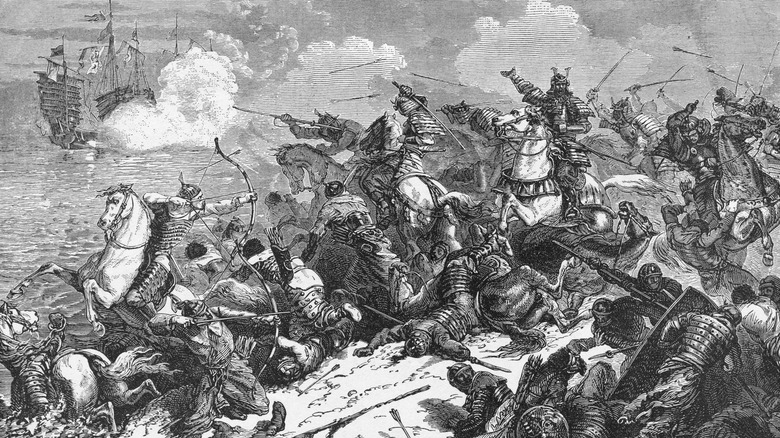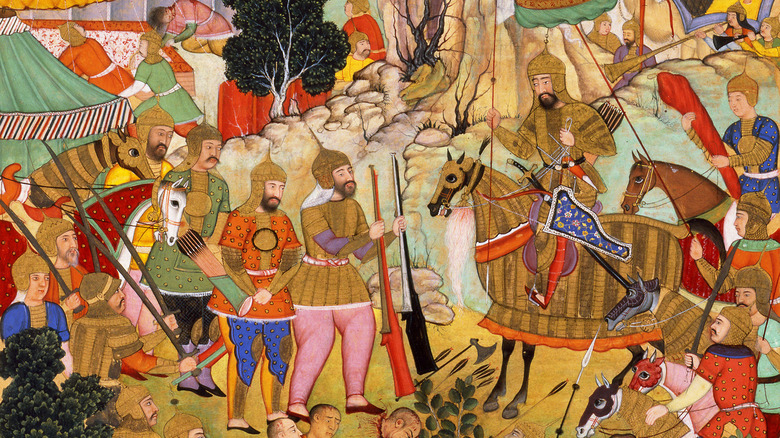The Hidden Truth About The Mongol Empire
In 1995, The Washington Post got a little ahead of schedule by naming their "man of the millennium" five years before the new one was upon us. The paper settled on one name as the great "doer" of civilization, the man whose will and actions, more than any other, connected and reshaped the world: Genghis Khan. The choice was disputed but, as the Post put it, "history is not just a tale of saints and geniuses and emancipators." Genghis Khan's conquests left millions dead and devastated once-vibrant societies, but they united vast swaths of the Old World and allowed trade to flourish along the Silk Road, further tying East and West together.
The formation of the Mongol Empire, as Genghis Khan's great project of conquest came to be known, was achieved by more than his own hand. His armies, his enemies, and his subjects all shaped the character of an empire with an impact far beyond its longevity. Just over a century of rule by the Mongols left an indelible impression upon subjugated peoples, influencing their policies long after the empire's fall. The Mongols, and their leader, have proved reliable heroes and villains in cultures throughout the world. They've been used in everything from novels to ill-fated John Wayne movies.
There's a rich vein of history for anyone to explore in the Mongol Empire, and plenty beyond the cliff-notes version of one man's war campaigns. Here are a few hidden gems about the history of the Mongol Empire.
The Mongols were warring tribes before Genghis Khan united them
Born with the name Temüjin in A.D. 1162, Genghis Khan came into a society divided into often-warring tribes. Such warfare claimed Temüjin's father's life before the boy was 10. He, his mother, and his siblings were cast out from their own clan and left to survive on their own on the steppes. Temüjin soon proved himself an adept, if ruthless, navigator of such a life; he killed his older half-brother to take over his family, escaped when his former clan captured him, and rescued his wife from a raiding party.
Along the way, Temüjin managed to win himself a devoted following. He broke with tradition by choosing allies of merit rather than his own family as his lieutenants. Wiping out rival chieftains and incorporating their followers into his own clan, Temüjin was well-positioned by 1206 to expand his ambitions. He called for a summit of clan chiefs, at which it was agreed that Temüjin would be the leader of them all. It was also at that meeting that he became known as Genghis Khan, or "universal ruler" of the Mongols.
In uniting the Mongol tribes, Genghis Khan forged a nation of roughly 1 million. He began state-building not long after his ascension, instituting writing systems, a census, and freedom of religion. He also sought to curb further infighting among the Mongols by abolishing contentious hereditary titles of nobility and ending enslavement of fellow Mongols.
The nations conquered by the Mongols were advanced but fractured
The first territory outside of the steppes of Mongolia that Genghis Khan targeted for war and conquest was China, specifically the Xi Xia kingdom on the northern border. He was reportedly driven by a sense of divine purpose; surviving texts claim that Genghis Khan, a follower of Tengriism, believed that he was destined to rule the world. His conviction of divine right may have been sincere, but an imperial endeavor had other appeals, plunder and control of lucrative trade routes among them. A thirst for vengeance against certain rulers and nations also fueled the Mongols' war lust.
Whatever the combination of motives, Genghis Khan and his followers didn't stop at Xi Xia. Having incorporated that kingdom into their empire, the Mongols took the Jin dynasty, then moved against Khara-Khitai and Khiva in Turkistan. Before Genghis Khan's death, the Mongol Empire had pushed its borders up against Persia, Tibet, and Russia, and it would grow considerably larger.
Many of the societies subjugated by the Mongols were highly developed and sophisticated. Khiva had an effective irrigation system for its farms, and the Jin dynasty had an impressive administrative apparatus. But in the case of China, the strengths of the state were offset by the weakness of division. China at that time existed as two separate entities, the Jin dynasty and the Song empire. There were also internal divisions within the Jin dynasty, which the Mongols exploited by winning some Jin fighters over to their cause.
The Mongols won by strategy, not numbers
The Mongols didn't conquer without contest. Armies came out to face them, and many had greater numbers than Genghis Khan. Unrest within the invaded nations could help to swell the Mongols' ranks, as could surrender; those who gave in to the Mongols without a fight could have their soldiers brought into the Mongol forces.
But the key to Mongol victories lay in strategy, not numbers. Genghis Khan's well-organized forces made ample use of horsepower. His cavalry, which constituted the bulk of his armies, could move at great speed and to devastating effect over open terrain. With their reputation preceding them, the Mongols would offer their targets a choice of voluntary surrender or utter devastation. In the event of war, bow and arrow assaults let the Mongols strike at a fair distance before moving in to engage the scattered forces of the enemy in close combat. Meanwhile, their own armies maintained an efficient messenger system that let them direct and coordinate movements.
Technology also worked in the Mongols' favor. Inventions that we have long taken for granted, like the stirrup, were a boon to their chances. And some of the nations conquered by the Mongols had a wealth of skilled artisans, soldiers, and craftsmen who could be conscripted. The aid of such people was invaluable when the Mongols turned to siege warfare, and many of their techniques and tactics in sieges were learned from the Chinese.
The Mongol empire was driven by, and drove, climate change
We tend to think of manmade climate change as a modern problem, the consequence of an industrial, global civilization and an impending adaptational challenge. But human activity was reshaping the Earth well before the internal combustion engine. We've caused climate change since we began practicing agriculture. Farming takes land, land that in some areas would otherwise be occupied by massive forests that soak up carbon.
The conquests of Genghis Khan left vast stretches of territory depopulated, through slaughter and through sending throngs fleeing the advancing Mongols. Fields were left unattended, allowing trees to reclaim them. The scale of the Mongol-driven depopulation was so large, and it lasted for so long, that forests were able to expand to such a degree that the Earth's climate cooled. Researchers from the Carnegie Institution's Department of Global Ecology told Mongabay that the reforestation indirectly caused by the Mongols absorbed 700 million tons of carbon from the atmosphere, the equivalent of the amount of carbon emitted by burning gasoline every year in modern society.
But if Genghis Khan inadvertently shaped the world's climate, it shaped him in turn. Research has suggested that, just before his rise to power, the Mongol steppes transitioned from drought conditions, which may have exacerbated tensions among the clans, to a string of mild years with plentiful rainfall. All that rain would have helped the grasses of the steppes, which in turn would have provided ample food for the cavalry horses on which Genghis Khan's forces depended.
The Mongol empire was equal parts innovative and destructive
While Genghis Khan still lived, the civil and economic systems of conquered territories were left a loose and often shattered mix stitched together by the authority of the khan. But the Mongols were quick in adapting to administration. And in connecting all of their territories through relay stations and mounted envoys, they enabled relatively quick communication. This also helped to facilitate trade, which may have been a driving force behind the Mongol invasions in the first place.
Travel and trade also benefited from a period of relative peace and stability after Genghis Khan's death. The years between about 1279 to 1368 have been referred to as "Pax Mongolica" (via National Geographic) for the stability within the Mongol Empire, a stability partly owed to the way the empire was organized. Once the Mongols took a territory, the state apparatus they built tended to follow local custom and employ many of rank and ability from the subjugated people, with a small number of Mongols as the final authority.
But Pax Mongolica was paid for by a long and bloody series of wars. The oft-cited statistic of Genghis Khan being responsible for 40 million deaths actually undersells the scale of devastation the Mongol invasions caused. The world population may have fallen by 11% because of them. And entire cultures, such as the Xi Xia kingdom, were almost completely destroyed.
The Mongol empire was largely decentralized
Expansive empires built up through conquest are, almost by their nature, multicultural. As the Mongol Empire expanded, it took on a largely decentralized character. Britannica describes it as less of a Mongol "empire" than distinct Chinese, Persian, and Asiatic empires held together under Genghis Khan's dynasty. While early episodes of conquest tried to impose Mongol culture without regard for local tradition or bureaucracy, counselors were drawn from all nations under their control. And as the Mongols moved from subjugation to administration, any given territory's government followed its own custom.
Not that such a decentralized arrangement spared any of the peoples of the Mongol Empire from exploitation. Mongol administrators were in every territory, and there was no question who held ultimate authority. The Mongols demanded tribute from their territories, be it taxes, soldiers, scholars, or artisans. How heavy the tribute could depend on the circumstances that brought a territory into the empire; the kingdom of Armenia voluntarily surrendered to Mongol control and was largely left alone, while others were left with little state to speak of after an invasion. In such situations, Mongols left in charge had ample opportunity to abuse the local populace.
The nature of the local governments appropriated sometimes worked in the Mongols' favor. The strength of the central government in China at the time of its assimilation provided a strong foundation for state-building. Beijing, under the name Dadu, became the center of the Mongol Empire under Kublai Khan.
The Mongol empire reached its largest extent after Genghis Khan's death
Genghis Khan is one of the most notorious warriors and conquerors in world history, with the body count to prove it. And within his lifetime, he managed to form an empire that reached the Pacific Ocean on its eastern border and the Caspian Sea on the west. But it was an empire of ruthless subjugation, continual military operation, exploitation by Mongol warlords left in charge of conquered territories, and the khan's power holding it all together. Genghis Khan was an extraordinary leader, but his empire wouldn't enjoy its Pax Mongolica until several decades after his 1227 death.
Nor had the empire reached its greatest territorial extent at that time. Two years after Genghis Khan's death, he was succeeded by his son Ögedei. It was under Ögedei that the Mongol Empire became the largest contiguous empire in the history of the world. Its western border was pushed as far as Hungary, and its northern border crept into modern-day Russia. Ögedei also moved to increase the presence of government in the conquered territories and to connect them; it was he who undertook construction of the relay system.
It was also under Ögedei that expansion of the empire halted, at least in the west. His armies retreated from the Hungarian border upon hearing of his death in 1241, halting a potential incursion deeper into Europe. But the borders established under his rule endured for another few decades, as did the power of the khanate.
The Mongols' experiment with paper money was a disaster
Mind was valued as much as martial force in the Mongol Empire. Intellectuals among the peoples they conquered were as prized as skilled workers and artisans. And significant advances in technology and mathematics happened under the patronage of the Mongols, if not always directly; an assemblage of scholars intended to help prolong the life of one of Genghis Khan's grandchildren produced notable developments in trigonometry.
Innovation comes through experimentation, and not all experiments work out on the first try. So it was with the Mongol Empire's attempt to introduce paper money, made from the bark of mulberry trees. Genghis Khan himself issued the currency in 1227, the same year of his death. His successors continued to innovate by retiring old notes and coins ahead of new issues and establishing a monetary division. Marco Polo counted the currency as among the more remarkable sights he beheld in his travels. But, not unlike the modern efforts of the United States to popularize the dollar coin, the Mongols had trouble getting their population to accept the paper money.
It wasn't for lack of trying. There was a rigorous authentication process in preparing the money, which was issued in 10, 20, 100, and 1,000 denominations by the time of Kublai Khan (per Mongolbank). And if that wasn't good enough, use of the paper notes was compulsory on pain of death. But people just didn't trust the notes, which didn't survive the collapse of the Mongol Empire in 1368.
Most of Genghis Khan's heirs were contested
Before his death, Genghis Khan selected his third-born son, Ögedei, to succeed him. Ögedei was described by contemporaries as a hard-drinking, harsh man of great passions. Two years passed between his father's death and his confirmation as great khan by the Mongol nobles. Ögedei expanded the empire and shifted its policies toward conquered lands, but his drinking caught up with him. He died in 1241.
After Ögedei, heirs to Genghis Khan's throne would regularly find their legitimacy contested. His son, Güyük, was elected great khan over Batu, the man who would have struck into western Europe in Ögedei's name had he not died (and was also Genghis Khan's grandson by his eldest son). Güyük died before the tension could create lasting damage to the empire, but the matter of his successor kept the Ögedei and Batu branches of the family in bitter contest. Sorqoqtani Beki, Batu's aunt, outmaneuvered the opposition and clinched the throne for her son Möngke. Under him, the Mongols took Baghdad and established territory on the Mediterranean. They also purged his family rivals.
When Möngke died, the next great khan seemed likely to be either Arigböge and his brother Kublai, sons of Genghis Khan's youngest son. The brothers fought a four-year civil war for the throne, ending with Kublai's victory in 1264. But he was never elected by a council of nobles, which left his position somewhat suspect among the Mongols even after he became great khan.
Attempted invasions of Japan weakened the Mongol empire
It's been said (via Britannica) that Möngke Khan, who ruled the empire from 1251 to 1259, was the last great khan to exercise uncontested rule over the whole of the Mongol Empire. Kublai Khan, his successor, was a capable warrior and statesman, and he did his grandfather one better on the Chinese front by bringing the southern Song dynasty under Mongol control. But Kublai Khan's reign was contested by some of his subjects and relatives, and the size, diversity, and decentralization of the empire had reached a point where the great khan's authority was, in many territories, nominal.
Kublai exercised his greatest control over the now-unified China, and he came to be seen as primarily a Chinese emperor, the father of the Yuan dynasty, despite trying to maintain Mongol supremacy. He proved adept at reconciling the Chinese to foreign rule, but his extravagance bred resentment. Among his expenses was continued attempts at conquest, which brought no new territory to the Mongol Empire after 1279.
Some of these failed campaigns proved disasters for the Mongols. Twice, once in 1276 and again in 1281, they attempted to take Japan on Kublai's orders. Both times, Japan was saved by typhoons. The first killed some 13,000 men when it struck the fleet in Hakata Bay, and the second destroyed nearly half of a 140,000-man force. It remains one of the great naval disasters in world history, and it cost Yuan China blood and treasure to no end.
The Golden Horde became the surviving rump of the Mongol empire
The Mongol Empire began to disintegrate after the death of Kublai Khan. His successors were faced with continuing rivalries among Mongol leaders, and many were heavily controlled from a young age by their ministers. In China, where Kublai's Yuan dynasty had its strongest base, the native Chinese culture began to exert itself over Mongol opposition. The Mongol nobility and the agricultural class of China were increasingly hostile to one another. Rebellion grew, and by 1368, the Yuan dynasty had been supplanted by the Ming. The last Yuan ruler fled back to the steppes and died two years later.
Outside of China, the Mongol Empire fractured into pieces. The most stable was the Golden Horde, created from western territories that Genghis Khan left his son Juchi to rule. Juchi's son Batu later expanded these holdings considerably. The Golden Horde stretched from Siberia into modern-day Hungary and controlled significant territory around the Black and Caspian Seas. As Kublai Khan and his descendants were influenced by Chinese culture, Batu's descendants were influenced by the Turkic and Islamic peoples they ruled.
But the Golden Horde wouldn't outlive the Yuan dynasty for long. It was badly struck by the Black Death, and it suffered military defeats by Russia and by its own allies. The Horde would break up into several smaller states throughout the 1400s. One of its successor khanates, based in the Crimea, absorbed the vestigial rump of the Horde in 1502.
